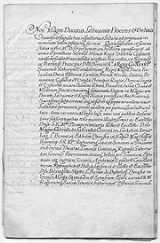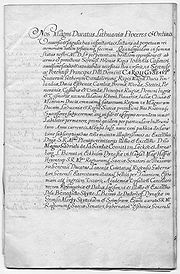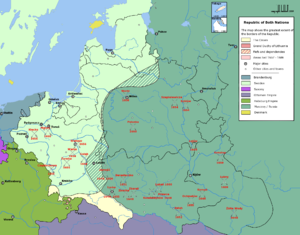
Union of Kedainiai
Encyclopedia


Magnate
Magnate, from the Late Latin magnas, a great man, itself from Latin magnus 'great', designates a noble or other man in a high social position, by birth, wealth or other qualities...
s of the Grand Duchy of Lithuania
Grand Duchy of Lithuania
The Grand Duchy of Lithuania was a European state from the 12th /13th century until 1569 and then as a constituent part of Polish-Lithuanian Commonwealth until 1791 when Constitution of May 3, 1791 abolished it in favor of unitary state. It was founded by the Lithuanians, one of the polytheistic...
and the king of the Swedish Empire
Swedish Empire
The Swedish Empire refers to the Kingdom of Sweden between 1561 and 1721 . During this time, Sweden was one of the great European powers. In Swedish, the period is called Stormaktstiden, literally meaning "the Great Power Era"...
, Charles X Gustav
Charles X Gustav of Sweden
Charles X Gustav also Carl Gustav, was King of Sweden from 1654 until his death. He was the son of John Casimir, Count Palatine of Zweibrücken-Kleeburg and Catherine of Sweden. After his father's death he also succeeded him as Pfalzgraf. He was married to Hedwig Eleonora of Holstein-Gottorp, who...
. It was signed on 20 October 1655 during the "Swedish Deluge", part of the Second Northern War
Second Northern War
The Second Northern War was fought between Sweden and its adversaries the Polish–Lithuanian Commonwealth , Russia , Brandenburg-Prussia , the Habsburg Monarchy and Denmark–Norway...
. In contrast the preceding Treaty of Kėdainiai
Treaty of Kėdainiai
The Treaty of Kėdainiai or Kiejdany, signed on 17 August 1655, was a Swedish–Lithuanian agreement during the Second Northern War. After the Polish forces had been decisively defeated in the Battle of Ujście, whereupon the Poznan and Kalisz palatines surrendered to Sweden, Lithuanian hetman Janusz...
of 17 August, which put Lithuania under Swedish protection, the purpose of the Swedish-Lithuanian union was to end Lithuania's union with Poland, and set up two separate principalities in the Grand Duchy of Lithuania. One of these was to be ruled by the Radziwiłł (Radvila) family, while the rest of the duchy was to remain a Swedish protectorate
Protectorate
In history, the term protectorate has two different meanings. In its earliest inception, which has been adopted by modern international law, it is an autonomous territory that is protected diplomatically or militarily against third parties by a stronger state or entity...
.
The agreement did not last for long and never came into effect, as the Swedish defeat in the Battles of Warka
Battle of Warka
The Battle of Warka on April 7, 1656 between forces of the Polish-Lithuanian Commonwealth commanded by Stefan Czarniecki on one side, and on the other Swedish forces commanded by Friedrich of Baden. Battle was fought for about two hours. Polish forces won the battle....
and Prostki
Battle of Prostki
The Battle of Prostki was fought near Prostki on October 8, 1656 between forces of the Polish-Lithuanian Commonwealth and allied Crimean Tatars commanded by hetman Wincenty Gosiewski on one side, and on the other allied Swedish and Brandenburg forces commanded by Prince Georg Friedrich of...
as well as a popular uprising in both Poland and Lithuania put an end both to Swedish power and the influence of the Radziwiłłs.
History
The Radziwiłł family was the owner of vast areas of land in Lithuania and Poland and some of its members were dissatisfied with the role of the magnates, who in the Polish–Lithuanian political system theoretically had the same rights as the Polish and Lithuanian nobilitySzlachta
The szlachta was a legally privileged noble class with origins in the Kingdom of Poland. It gained considerable institutional privileges during the 1333-1370 reign of Casimir the Great. In 1413, following a series of tentative personal unions between the Grand Duchy of Lithuania and the Kingdom of...
. Eventually, the interests of the wealthy clan, known as "The Family", and the Crown began to drift apart.
In 1654, during the Swedish and Russian invasion of Poland, known as "The Deluge", two notable members of the Radziwiłł clan, Janusz and Bogusław
Boguslaw Radziwill
Bogusław Radziwiłł was a princely magnate and a member of the Polish-Lithuanian szlachta, or nobility. He was of the Lithuanian Radziwiłł noble family...
, began negotiations with Swedish king Charles X Gustav
Charles X Gustav of Sweden
Charles X Gustav also Carl Gustav, was King of Sweden from 1654 until his death. He was the son of John Casimir, Count Palatine of Zweibrücken-Kleeburg and Catherine of Sweden. After his father's death he also succeeded him as Pfalzgraf. He was married to Hedwig Eleonora of Holstein-Gottorp, who...
, aimed at dissolving the Commonwealth and the Polish–Lithuanian Union. At that time the Grand Duchy of Lithuania was attacked on two separate fronts by Russia and Sweden, and political control over its area deteriorated. The Lithuanian army capitulated to the Swedes and the state collapsed. Most of the Crown of Poland along with western parts of Lithuania
Lithuania
Lithuania , officially the Republic of Lithuania is a country in Northern Europe, the biggest of the three Baltic states. It is situated along the southeastern shore of the Baltic Sea, whereby to the west lie Sweden and Denmark...
were occupied by Swedish forces, while most of the Grand Duchy (except Samogitia
Samogitia
Samogitia is one of the five ethnographic regions of Lithuania. It is located in northwestern Lithuania. Its largest city is Šiauliai/Šiaulē. The region has a long and distinct cultural history, reflected in the existence of the Samogitian dialect...
and parts of Suvalkija
Suvalkija
Suvalkija or Sudovia is the smallest of the five cultural regions of Lithuania. Its unofficial capital is Marijampolė. People from Suvalkija are called suvalkiečiai or suvalkietis . It is located south of the Neman River, in the former territory of Vilkaviškis bishopric...
and Aukštaitija
Aukštaitija
Aukštaitija is the name of one of five ethnographic regions of Lithuania. The name comes from the relatively high elevation of the region, particularly the eastern parts.-Geography:...
) was under Russian occupation. In addition, the Khmelnytsky Uprising
Khmelnytsky Uprising
The Khmelnytsky Uprising, was a Cossack rebellion in the Ukraine between the years 1648–1657 which turned into a Ukrainian war of liberation from Poland...
was taking place in Ukraine
Ukraine
Ukraine is a country in Eastern Europe. It has an area of 603,628 km², making it the second largest contiguous country on the European continent, after Russia...
.
_2.jpg)
Treaty of Kėdainiai
The Treaty of Kėdainiai or Kiejdany, signed on 17 August 1655, was a Swedish–Lithuanian agreement during the Second Northern War. After the Polish forces had been decisively defeated in the Battle of Ujście, whereupon the Poznan and Kalisz palatines surrendered to Sweden, Lithuanian hetman Janusz...
, putting the Grand Duchy under Swedish protection. On 10 October 1655 (O.S.
Old Style and New Style dates
Old Style and New Style are used in English language historical studies either to indicate that the start of the Julian year has been adjusted to start on 1 January even though documents written at the time use a different start of year ; or to indicate that a date conforms to the Julian...
), Janusz and Bogusław Radziwiłł signed an agreement with the Swedes at their castle at Kėdainiai
Kedainiai
Kėdainiai is one of the oldest cities in Lithuania. It is located on the Nevėžis River. First mentioned in the 1372 Livonian Chronicle of Hermann de Wartberge, its population as of 2008 was 30,214. Its old town dates to the 17th century....
. According to the treaty, signed by the two cousins in the name of all Lithuanian nobility, the Polish–Lithuanian Union was declared null and void. In exchange for military assistance against Russia, the Grand Duchy of Lithuania was to become a protectorate of Sweden
Sweden
Sweden , officially the Kingdom of Sweden , is a Nordic country on the Scandinavian Peninsula in Northern Europe. Sweden borders with Norway and Finland and is connected to Denmark by a bridge-tunnel across the Öresund....
, with a personal union
Personal union
A personal union is the combination by which two or more different states have the same monarch while their boundaries, their laws and their interests remain distinct. It should not be confused with a federation which is internationally considered a single state...
joining two states. In addition, The Family was to be given two sovereign principalities carved from their lands within the Grand Duchy and the Lithuanian nobility was to retain its liberties and privileges.
The agreement never came into force. Its main proponent, Janusz Radziwiłł, died only 2 months after its signing, on December 31, in the Tykocin Castle
Tykocin Castle
The Tykocin Royal Castle is a 15th century castle located on the right bank of the river Narew in Tykocin, Poland. It fell into ruin in the 18th century and its reconstruction began in 2002.-History:...
, besieged by forces loyal to the King of Poland and the Grand Duke of Lithuania Jan Kazimierz. Shortly after his death, the castle was taken by Paweł Jan Sapieha
Paweł Jan Sapieha
Paweł Jan Sapieha was a Polish-Lithuanian nobleman .Paweł Jan became a Hussar Rotmistrz in 1633, courtier in 1635, Obozny of Lithuania in 1638, Podstoli of Lithuania in 1645, voivode of the Witebsk Voivodeship in 1646, voivode of the Vilnius Voivodeship and Great Hetman of Lithuania in 1656.He...
, who immediately succeeded Janusz Radziwiłł on the office of Grand Hetman of Lithuania. The tide of the war soon turned and a popular uprising in Poland broke the power of the Swedish army. The Swedish occupation of Lithuania sparked a similar uprising in Lithuania. The Swedish defeat and eventual retreat from the territories of the Commonwealth abruptly ended the plans of Janusz's cousin Bogusław, who lost his army in the Battle of Prostki
Battle of Prostki
The Battle of Prostki was fought near Prostki on October 8, 1656 between forces of the Polish-Lithuanian Commonwealth and allied Crimean Tatars commanded by hetman Wincenty Gosiewski on one side, and on the other allied Swedish and Brandenburg forces commanded by Prince Georg Friedrich of...
and died in exile in Königsberg
Königsberg
Königsberg was the capital of East Prussia from the Late Middle Ages until 1945 as well as the northernmost and easternmost German city with 286,666 inhabitants . Due to the multicultural society in and around the city, there are several local names for it...
on December 31, 1669.
The Radziwiłł family fortunes waned with the next generation. Bogusław became commonly known in Poland as Gnida ("Louse
Louse
Lice is the common name for over 3,000 species of wingless insects of the order Phthiraptera; three of which are classified as human disease agents...
") by his fellow nobles
Nobility
Nobility is a social class which possesses more acknowledged privileges or eminence than members of most other classes in a society, membership therein typically being hereditary. The privileges associated with nobility may constitute substantial advantages over or relative to non-nobles, or may be...
and Janusz became known as Zdrajca (Traitor). Their treason against the Polish–Lithuanian Commonwealth eclipsed the deeds of other members of their family, like Michał Kazimierz Radziwiłł, who fought for the Crown and the Commonwealth against the Swedes.
Assessment
Although seen as an act of treason by contemporaries, modern views on the proposed Swedish-Lithuanian agreement differ. Some argue that the agreement with the Swedes was made not out of greed and the political ambitions of Janusz Radziwiłł, but rather because of his RealpolitikRealpolitik
Realpolitik refers to politics or diplomacy based primarily on power and on practical and material factors and considerations, rather than ideological notions or moralistic or ethical premises...
. According to another theory, Janusz Radziwiłł attempted to get a strong ally against Russia. Supporters of this theory point out that this move was forced because the Grand Duchy of Lithuania lacked the resources to fight a two front war, and the Polish Crown didn't help either with financing or with military forces. Although this choice proved wrong - the Swedes proved to be not much better than Russians themselves.

